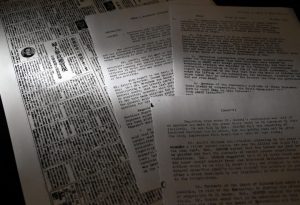Striving to fill voids in Hiroshima, Chugoku Shimbun and the press code — Surveillance of articles with A-bombing content, Part 4: Asahi Shimbun publication suspended
Sep. 23, 2023
Offending articles carried comments by politician Ichiro Hatoyama critical of A-bombings
A total of 94 news articles and one advertisement carried in the Chugoku Shimbun were judged as being in violation of the press code issued by the General Headquarters of the Allied Powers (GHQ) through its system of post-print censorship. One of the articles contained A-bombing content. After an investigation into GHQ and other materials, we found that the Chugoku Shimbun had never been ordered to suspend publication for violations of the press code but had received written warning.
Punishment handed down to newspapers through the GHQ censorship system included the well-known case of the Asahi Shimbun’s suspension of publication, which happened soon after the occupation of Japan had begun. The punishment was announced on September 18, 1945, one day prior to issuance of the press code by the GHQ. By that time, the Civil Censorship Detachment (CCD), a department under the auspices of the GHQ, had already begun its work. The reason provided for the punishment was that information carried in certain articles was in violation of a memorandum issued by the GHQ on September 10, when it announced its policy regarding implementation of the censorship system. The punishment resulted in the company being prohibited from publishing the Tokyo Asahi Shimbun morning edition of its newspaper over the two days of September 19 and 20th.
The five Asahi Shimbun articles deemed to be in violation of the press code had been published during the period September 15-17. According to Watashi no Asahi Shimbun-sha Shi (in English, ‘My history at the Asahi Shimbun’), a publication authored by Kyozo Mori, an editorial writer who later became the paper’s president, the GHQ viewed two of the articles in particular as being problematic. The articles in question were, in English, “Ideas for creation of a new party: Ichiro Hatoyama,” published on September 15, 1945, and “The military explains: The people’s voices on the announcement of ‘Atrocities in the Philippines’,” published on September 17, 1945.
Hatoyama called for support of Japan’s recovery
An article reporting on an interview with Ichiro Hatoyama, a politician who would later become prime minister of Japan, included comments he made that were critical of the atomic bombings.
Mr. Hatoyama asserted that the United States could not claim that the use of the atomic bombs and the killing of innocent civilians were not violations of international law and war crimes, so long as that nation advocated the idea that “justice is power.” He called on the United States to witness the devastation of the A-bombed cities and to provide support for recovery.
Mr. Hatoyama’s comments were “considered as being destructive criticism of the Allied occupation and an obstacle to occupation policies” (excerpted from “History of the Asahi Shimbun — Post-war Showa edition”).
Mr. Mori explained his thinking about the issue in his publication, revealing that, “I knew his comments might provoke the GHQ, but I decided to run the article anyway because I thought it was something that a Japanese person absolutely needed to say.”
“In the time after the suspension of publication, the GHQ system of censorship turned out to be even stricter than that used by the former Japanese military.” Mr. Mori added, “Furthermore, we were not allowed to leave blank spaces in the newspaper, as that would imply that the information had been deleted due to censorship. It was difficult work to quickly fill those spaces.”
On September 19, during the suspension of publication, CCD Director Donald Hoover and Asahi Shimbun executives gathered for a meeting. The GHQ materials include records of the meeting. According to those records, the newspaper’s executives explained that Mr. Hatoyama “might have made a slip of the tongue because he holds liberal ideas.”
“Against interests”
The punishment levied against the Asahi Shimbun was a sign that the GHQ was unnerved by the reporting about the atomic bombings in the early period after the occupation began. Rinjiro Sodei, professor emeritus of Hosei University and a specialist in the history of Japan’s occupation, wrote, “The media reports on the atomic bombings were designated as falling under ‘destructive criticism against the interests of the Allied Occupation and Allied troops,’ information prohibited by the press code.” The above appeared in Mr. Sodei’s co-authored publication Kouza/Komyunikeshon 5 Jiken to Hodo (‘Lecture/communication, volume 5: Incidents and reporting’).
As a result of the punishment, fewer articles with A-bombing content were carried in Japanese newspapers.
The following is an excerpt of comments related to the atomic bombings included in the interview with Ichiro Hatoyama (published September 15, 1945, in the Tokyo Asahi Shimbun morning edition), which was given as one of the reasons for the suspension of publication of the Asahi Shimbun.
“So long as the United States proclaims that ‘justice is power,’ I do not believe that nation can deny that the use of the atomic bombs and the massacre of innocent civilians are violations of international law and war crimes, worse even than attacks on hospital ships or the use of poison gas. Our efforts must be focused on having Americans confront the devastation of the affected areas and make them aware of their own desire to provide compensation for their actions and of their responsibility in reconstruction. By openly demonstrating that Japan alone has no prospect of recovery, we can have them realize that Japan’s democratic recovery and participation in international trade do not conflict with the interests of the United States and the welfare of the world. We must do everything we can to convince the United States to offer its support for Japan’s recovery.”
(Originally published on September 23, 2023)








